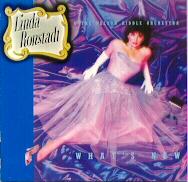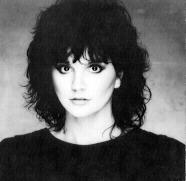Life After Rock
The first time I heard the prophecy was in the late 1960s, when Teddy Wilson, the classically graceful jazz pianist, told me: "Some of these kids who are playing and listening to rock are truly musical, and in time they're going to get very bored with the repetition of it all. They're going to look for other things- like melodies." The kind of melodies that never end.
 There's a new album that I expect Teddy will enjoy a lot. It's by a rock superstar, Linda
Ronstadt, but the songs are all from those pre-rock evenings when Frank Sinatra stood, almost
as thin as the microphone stand, in front of the Tommy Dorsey band, and Billie Holidav wore a
white gardenia in her hair. Among the songs in the air were "I've Got a Crush on You," "Crazy
He Calls Me," "Lover Man," "What'll I Do," "Good-Bye."
There's a new album that I expect Teddy will enjoy a lot. It's by a rock superstar, Linda
Ronstadt, but the songs are all from those pre-rock evenings when Frank Sinatra stood, almost
as thin as the microphone stand, in front of the Tommy Dorsey band, and Billie Holidav wore a
white gardenia in her hair. Among the songs in the air were "I've Got a Crush on You," "Crazy
He Calls Me," "Lover Man," "What'll I Do," "Good-Bye."
In this new Ronstadt set, there is nothing remotely resembling a rock beat in the background. There is a forty-seven-piece orchestra, with occasional ardently contemplative solos by jazz musicians. All the arrangements are by the orchestra's conductor, sixty-two-year-old Nelson Riddle, best known years ago for his custom-tailoring of stylish backgrounds to Frank Sinatra.
The album is called What's New and, in one sense, it began in Ronstadt's childhood, when her father played recordings of singers who were musicians and of musicians who could make their horns sing.
The more recent impetus for this rather startling turn in Ronstadt's career was a seminar held a few summers ago in the Long Island home of record producer Jerry Wexler. He knows more about jazz, blues, rock, and pop music than anyone I have ever met, and he brings to them all what used to be called a literary sensibility. (Decades ago, Wexler was a distinguished short-story writer.) I mention this because you can't successfully perform songs like these in What's New only as music. You have to make listeners believe each song is about you.
 Ronstadt heard a lot of songs and performers from the pre-rock years in Wexler's living room.
Among them was Mildred Bailey, of whom the transformed rock queen says: "She had a particular
diction that was very precise and very American, and there was this very innocent sexuality
that I loved."
Ronstadt heard a lot of songs and performers from the pre-rock years in Wexler's living room.
Among them was Mildred Bailey, of whom the transformed rock queen says: "She had a particular
diction that was very precise and very American, and there was this very innocent sexuality
that I loved."
That description almost exactly fits Ronstadt's singing in What's New, although she is entirely herself, not Mildred Bailey or anyone else. The warm, open, never overdramatized performances are not jazz singing. This is the art of the popular song, which some had thought might well never again be contemporary.
Ronstadt is beginning to revitalize the tradition, but on her own terms. The sensibility is of a thirty-seven-year-old who has lived these lyrics and connects with the melodies in ways that are of her generation, not Frank Sinatra's or Tony Bennett's. She has just chosen to be more musical than she has ever been before. Or, as she says:
"I wanted the pure melodies to come out."
There is talk in the music business of how Ronstadt's courage is pulling a switch on her legions of young record-buying admirers, to most of whom these songs are as unknown as Schubert lieder. Is Ronstadt worried? Her answer, in Time, indicates that something has happened to this woman that just can't be changed: "I don't know what my fans will think of it. I don't care too much. I hope they like it, but if they don't there is nothing I can do about it."
This doesn't mean she has abandoned rock. But I think she will hear differently from now on,
move differently, and daydream differently.